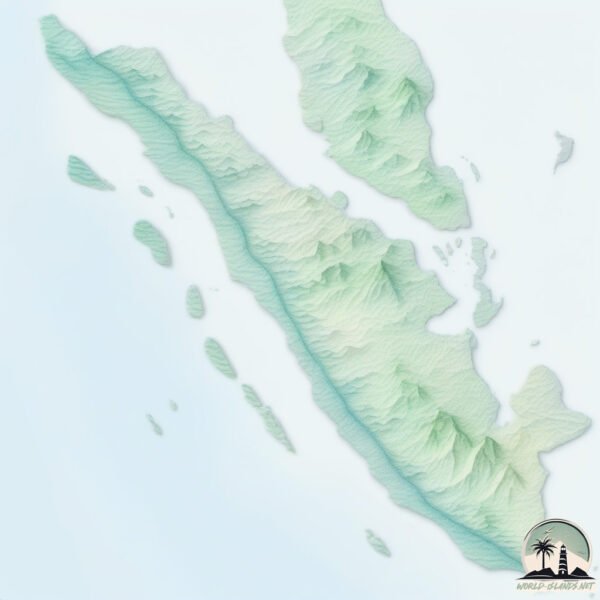Sumatra

Welcome to Sumatra, a Tropical island in the South China Sea, part of the majestic Indian Ocean. This guide offers a comprehensive overview of what makes Sumatra unique – from its geography and climate to its population, infrastructure, and beyond. Dive into the details:
- Geography and Size: Explore the island’s size and location.
- Climate and Weather: Weather patterns and temperature.
- Topography and Nature: Uncover the natural wonders of the island.
- Infrastructure and Travelling: Insights on reaching, staying, and making the most of your visit.
- News and Headlines: Latest News.
Geography and size of Sumatra
Size: 428134 km²
Coastline: 13205 km
Ocean: Indian Ocean
Sea: South China Sea
Continent: Asia
Sumatra is a Colossal Island spanning 428134 km² with a coastline of 13205 km.
Archipel: Greater Sunda Islands – A group of large islands in Southeast Asia, including Borneo, Sumatra, Java, and Sulawesi, known for their rich biodiversity and cultural diversity.
Tectonic Plate: Sunda – Extends across Southeast Asia, encompassing parts of the Sunda Shelf, known for its interaction with the Australian Plate, contributing to volcanic activity in Indonesia.
The geographic heart of the island is pinpointed at these coordinates:
Latitude: -0.45005873 / Longitude: 101.50724375
Climate and weather of Sumatra
Climate Zone: Tropical
Climate Details: Tropical Rainforest Climate
Temperature: Hot
Climate Characteristics: This climate is typified by heavy rainfall throughout the year, high humidity, and consistently high temperatures, leading to lush rainforests and rich biodiversity. Seasonal temperature variations are minimal.
Topography and nature of Sumatra
Timezone: UTC+07:00
Timezone places: Asia/Jakarta
Max. Elevation: 3805 m Gunung Kerinci
Mean Elevation: 311 m
Vegetation: Evergreen Broadleaf Forest
Tree Coverage: 56%
The mean elevation is 311 m. Dominating the island’s landscape, the majestic “Gunung Kerinci” rises as the highest peak, soaring to impressive heights. The island is characterized by Mountains: High, steeply elevated landforms. Characterized by both a high maximum elevation (over 500 meters) and a high mean elevation, creating rugged, mountainous terrains on islands.
Dominating Vegetation: Evergreen Broadleaf Forest
Characterized by dense, lush canopies of broadleaf trees that retain their leaves year-round. These forests are typically found in tropical and subtropical regions and are known for their high biodiversity. Sumatra has a tree cover of 56 %.
Vegetation: 17 vegetation zones – Exceptionally Diverse Island
Islands with more than ten vegetation zones are among the most ecologically rich and varied in the world. These islands are akin to miniature continents, boasting an incredible array of ecosystems. The sheer range of habitats, from high peaks to deep valleys, rainforests to deserts, creates a mosaic of life that is unparalleled. They are crucial for conservation and ecological studies.
Infrastructure and Travelling to Sumatra
Does the island have a public airport? yes.
Sumatra has a public and scheduled airport. The following airports are located on this island: Syekh Hamzah Fansyuri Airport, Departi Parbo Airport, Sultan Syarif Kasim II International Airport / Roesmin Nurjadin AFB, Pinang Kampai Airport, Muko Muko Airport, Radin Inten II International Airport, Aek Godang Airport, Tabing Airport, Kualanamu International Airport, Silangit Airport, Dr. Ferdinand Lumban Tobing Airport, Alas Leuser Airport, Sultan Thaha Airport, Muara Bungo Airport, Fatmawati Soekarno Airport, Sultan Mahmud Badaruddin II Airport, Pendopo Airport, Minangkabau International Airport, Cut Nyak Dhien Airport, Rembele Airport, Malikus Saleh Airport, Sultan Iskandar Muda International Airport.
Does the island have a major port? yes.
Sumatra is home to a major port. The following ports are situated on the island: PALEMBANG, PANJANG, TELUK BAYUR, PANGKALANSUSU, DUMAI, SUNGAIGERONG, RAMBA, BELAWAN.
The mean population of Sumatra is 127 per km². Sumatra is Moderately Inhabited. The island belongs to Indonesia.
The name of the island resonates across different cultures and languages. Here is how it is known around the world: Arabic: سومطرة; German: Sumatra; Spanish: Sumatra; French: Sumatra; Portuguese: Sumatra; Russian: Суматра; Chinese: 蘇門答臘
Continuing your journey, Pulau Borang is the next notable island, situated merely km away.
Sumatra Indonesia Travel Guide: 17 BEST Things To Do In Sumatra



Indonesia is classified as Emerging region: MIKT: Mexico, Indonesia, South Korea, and Turkey – Economies recognized for their development potential and emerging market status. The level of income is Lower middle income.
News – Latest Updates and Headlines from Sumatra
Stay informed with the most recent news and important headlines from Sumatra. Here’s a roundup of the latest developments.
Social Media Posts about Sumatra
Please note: The data used here has been primarily extracted from satellite readings. Deviations from exact values may occur, particularly regarding the height of elevations and population density. Land area and coastline measurements refer to average values at mean high tide.
